Tiber River
| Tiber | |
|---|---|
| Origin | Mount Fumaiolo |
| Mouth | Tyrrhenian Sea |
| Basin countries | Italy |
| Length | 406 km (252 mi) |
| Source elevation | 1,268 m (4,160 ft) |
| Avg. discharge | 267 m3/s (9,400 cu ft/s) (in Rome) |
| Basin area | 17,375 km2 (6,709 sq mi) |
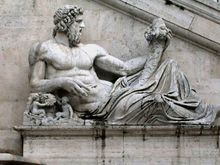
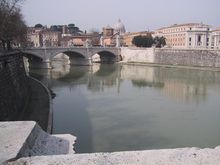

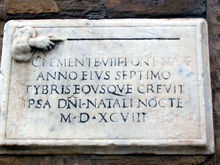
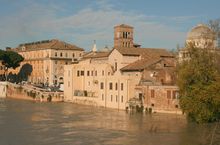
The Tiber (Latin Tiberis, Italian Tevere, Italian pronunciation: [ˈte(ː)vere])[1] is the third-longest river in Italy, rising in the Apennine mountains in Emilia-Romagna and flowing 406 kilometres (252 mi) through Umbria and Lazio to the Tyrrhenian Sea.[2] It drains a basin estimated at 17,375 square kilometres (6,709 sq mi). The river has achieved lasting fame as the main watercourse of the city of Rome, founded on its eastern banks.
Contents |
Source of the Tiber
The source of the Tiber consists of two springs 10 metres away from each other on Mount Fumaiolo. These springs are called "Le Vene."[3] The springs are in a beech forest 1,268 metres above sea level. During the 1930s, Benito Mussolini placed an antique marble Roman column at the point where the river arises, inscribed QUI NASCE IL FIUME SACRO AI DESTINI DI ROMA ("Here is born the river / sacred to the destinies of Rome"). There is an eagle on the top of this column. The first miles of the Tiber run through Valtiberina before entering Umbria.[4]
Name and legends
It is probable that the name Tiber is pre-Latin, like the Roman name of Tibur (modern Tivoli). It may be Etruscan or Italic in origin, possibly akin to the Celtic root-word dubr, "water". The same root is believed to be the source of the Latin praenomen Tiberius, and its Etruscan cognate, Thefarie.[5][6]
The legendary king Tiberinus Silvius, or Thebris, ninth in the king-list of Alba Longa, was said to have drowned in the Albula River, which was subsequently renamed in his honour.[5] The myth may have explained a memory of an earlier, perhaps pre-Indo-European name for the river, "white" (alba) with sediment. According to the legend, Jupiter made him a god and guardian spirit of the river (also called Volturnus, "rolling water"). This gave rise to the standard Roman depiction of the river as a powerfully built reclining river god, also named Tiberinus, with streams of water flowing from his hair and beard.[7] The River Tiber was also believed to be the river into which Romulus and Remus (the former founded Rome) were thrown as infants.
History
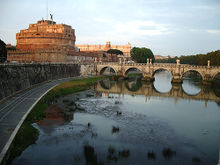
According to legend, the city of Rome was founded in 753 BC on the banks of the Tiber about 25 km from the sea at Ostia. The island Isola Tiberina in the center of Rome, between Trastevere and the ancient center, was the site of an important ancient ford and was later bridged. Legend says Rome's founders, the twin brothers Romulus and Remus, were abandoned on its waters, where they were rescued by a she-wolf.
The river marked the boundary between the lands of the Etruscans to the west, the Sabines to the east and the Latins to the south. Benito Mussolini, born in Romagna, adjusted the boundary between Tuscany and Emilia-Romagna, so that the springs of the Tiber would lie in Romagna.
The Tiber was critically important to Roman trade and commerce, as ships could reach as far as 100 kilometres (60 mi) upriver; there is evidence that it was used to ship grain from the Val Teverina as long ago as the 5th century BC.[8] It was later used to ship stone, timber and foodstuffs to Rome.
During the Punic Wars of the 3rd century BC, the harbour at Ostia became a key naval base. It later became Rome's most important port, where wheat, olive oil, and wine were imported from Rome's colonies around the Mediterranean.[8] Wharves were also built along the riverside in Rome itself, lining the riverbanks around the Campus Martius area. The Romans connected the river with a sewer system (the Cloaca Maxima) and with an underground network of tunnels and other channels, to bring its water into the middle of the city.
The heavy sedimentation of the river made it difficult to maintain Ostia, prompting the emperors Claudius and Trajan to establish a new port on the Fiumicino in the 1st century AD. They built a new road, the via Portuensis, to connect Rome with Fiumicino, leaving the city by Porta Portese ('the port gate'). Both ports were eventually abandoned due to silting.
Several popes attempted to improve navigation on the Tiber in the 17th and 18th century, with extensive dredging continuing into the 19th century. Trade was boosted for a while but by the 20th century silting had resulted in the river only being navigable as far as Rome itself.[8]
The Tiber was once known for its floods — the Campus Martius is a flood plain and would regularly flood to a depth of several metres. The river is now confined between high stone embankments which were begun in 1876. Within the city, the riverbanks are lined by boulevards known as lungoteveri, streets "along the Tiber."
Because the river is identified with Rome, the term "swimming the Tiber" has come to be the Protestant shorthand term for converting to Roman Catholicism. This is most common if the person who converts had been Anglican, the reverse of which is referred to as "Swimming the Thames."
In ancient Rome, executed criminals were thrown into the Tiber. People executed at the Gemonian stairs were thrown in the Tiber during the latter part of the reign of the emperor Tiberius. This practice continued over the centuries. For example, the corpse of Pope Formosus was thrown into the Tiber after the infamous Cadaver Synod held in 897.
Bridges over the Tiber
In addition to numerous modern bridges over the Tiber in Rome, there remain several ancient bridges (now mostly pedestrian-only) that have survived in part (e.g., the Milvian Bridge and the Ponte Sant'Angelo) or in whole (Fabricius' Bridge).
Popular culture
The popular real-time strategy videogame series Command & Conquer features an extraterrestial mineral called "Tiberium"; the meteor by which it arrived at Earth crashed near the Tiber River.
In the book Encounter with Tiber, Tiber is the name of a planet in the Alpha Centauri system.
In the video game series The Elder Scrolls, there is an emperor named Tiber Septim, presumably after the famous river.
References
- ↑ (Italian) Dizionario d'ortografia e di pronunzia
- ↑ Lazio - Latium | Italy
- ↑ Tiber Springs - Mount Fumaiolo
- ↑ Tuscany tours - the origin of the Tiber River
- ↑ 5.0 5.1 "Tiber". Concise Dictionary of World Place-Names. John Everett-Heath. Oxford University Press 2005.
- ↑ George Davis Chase, "The Origin of Roman Praenomina", in Harvard Studies in Classical Philology, vol. VIII (1897)
- ↑ Tiber. Bloomsbury Dictionary of Myth (1996)
- ↑ 8.0 8.1 8.2 "Tiber River." Encyclopædia Britannica. 2006
|
||||||||||||||||||||